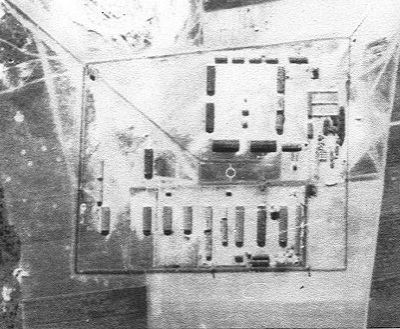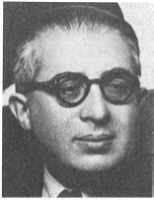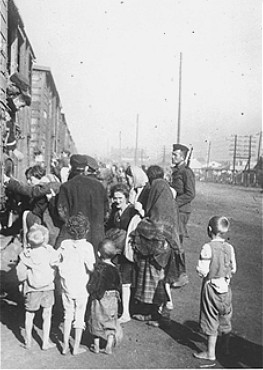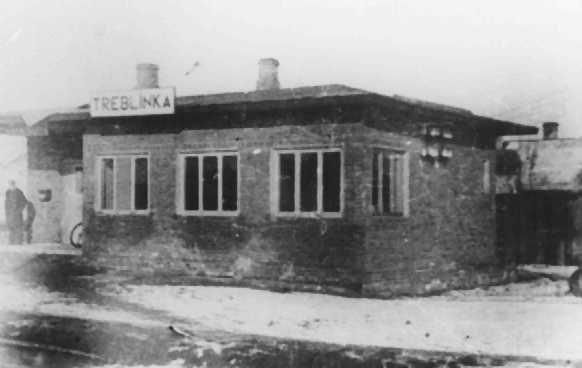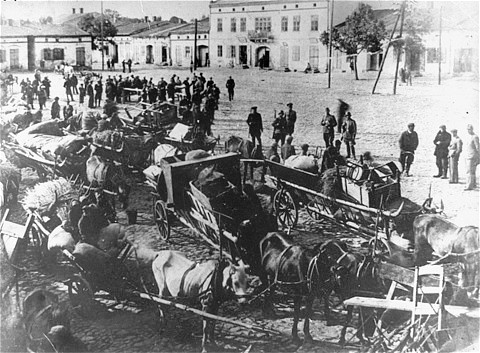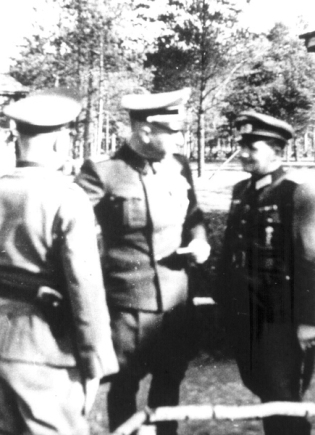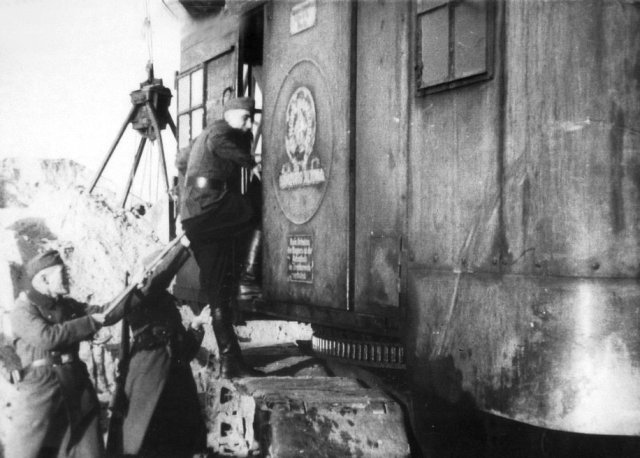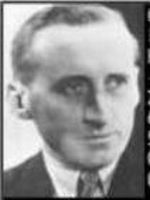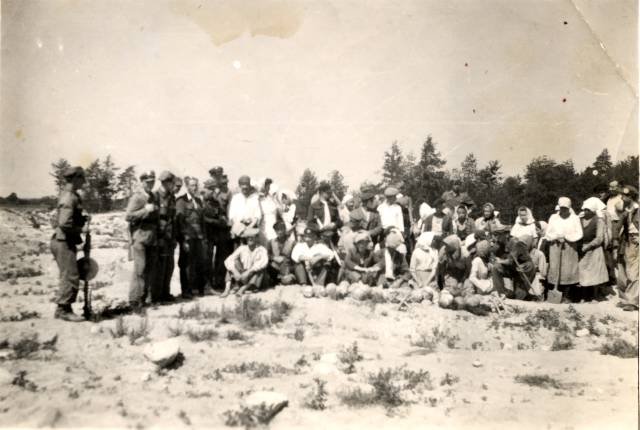Introduction
Samuel Rajzman is one of the very few survivors of the Treblinka extermination camp – he was lucky enough to escape. The testimony he gave, more than 60 years ago, is still important enough to understand the horror of the crimes that were committed in that camp in connection with the Endlösung der Judenfrage (Final solution of the Jewish Problem). Before the war he worked with the Miedzyrzecki Overseas Import & Export Company in Warsaw. His testimony, delivered in 1945 before the American House Committee on Foreign Affairs follows.
Definitielijst
- Endlösung
- Euphemistic term for the final solution the Nazis had in store for the “Jewish problem”. Eventually the Endlösung would get the form of annihilating the entire Jewish people in extermination camps.
Images
Deportation
In June 1942 placards bearing the following notice were posted on the walls of Warsaw: "Persons not employed in a German firm or the Jewish Community Administration are subject to immediate deportation from the ghetto, the able-bodied will be given employment."
About the place of deportation, nothing was known except that it was in the East. Next to the new posters, there immediately appeared "Help wanted" advertisements of German firms.
The factories, stores and workshops owned by the Jews had been turned over to German administrators, thus a great number of new German firms had been created. People paid fantastic sums (from 5 to 20 thousand zlotys, $1,000 to $4,000 per person) to find employment in a German firm and thus escape deportation. Those who had still anything to sell converted it into cash but those that had no funds were doomed.
The day after this announcement, it became known that Engineer Czemiakow, President of the Jewish Community, had committed suicide. This report spread panic among the inhabitants of the ghetto. They knew that the German order concerning deportation had caused his suicide, but it was not clear why, all kinds of conjecture were advanced in explanation, but although the event boded no good, not even the worst pessimists had any idea what was really in store for the Polish Jews.
Next day, the ghetto was surrounded by patrols at short intervals, these prevented anyone from leaving or entering the ghetto, even Gentiles who possessed special passes, entitling them to circulate freely in the Jewish Quarter.
The ghetto now became a real inferno, processions of carts loaded with little children from orphanages and charity homes passed along the streets. These frightening and trembling mites were being deported, they did not know that never again would they see the city where they had been born and brought up.
Behind the children’s carts walked inmates from old people’s homes, aged men and women tottering on their feet, who were forbidden to end their lives in their own city. The Elite Guards escorted the processions. Then the Germans began to check the documents of the remaining inhabitants.
Soldiers swarmed everywhere in the streets and houses, they searched cellars and attics and asked everyone to show his identification papers. Those who could not prove they were employed in a German firm were taken to the square where the deportees were rounded up.
These manhunts resulted in many victims, the slightest gesture of disobedience, the slightest hesitation before showing one’s papers, a smile the Germans did not find sufficiently pleasant, meant death on the spot. People were killed in their homes, in their courtyards, in the streets. In the end, many preferred to be deported to having their papers checked.
The deportees were crowded into trains, at first at the rate of 6 to 8 thousand a day- subsequently the average daily contingent was 20,000. Several weeks later it became known that the Germans had murdered all the old people and children and that the able-bodied had allegedly been taken deep into Russia.
The news of the murder of the old folks aroused those who remained to desperate thoughts about counter-measures. When the Germans realized this, they forced the deportees to send letters informing them that they were alive and that all was well with them.
The purpose of hose letters which the Nazis frightened the deportees into writing before killing them, was to prevent further rumors, under the threat of death, people wrote to relatives whom they were never to see again. This event took place on the square where the victims were gathered.
In the terrible ordeal of the ghetto, children were taken away from their mothers, people were beaten and murdered for no reason at all, those who ventured into the streets did not return.
By September, only 150,000 Jews of the original 600,000 remained in the Jewish community. However, it was impossible to obtain exact information on their condition because the ghetto was deserted, the employees of the German firms were now its only inhabitants.
After a short respite, on September 7, 1942, if I remember correctly new placards announced that all the remaining inhabitants of the ghetto must report to the assembly place of Mila, Nizka and Dzika streets at 8 a.m. to have their identity papers checked.
The horrible scene presented by this migration of 150,000 people with bundles on their backs can be imagined. Crowds of Jews filled the narrow streets within a few hours.
At exactly 8 a.m. cordons of troops barred all the exits to the above-named streets, those who were found in the ghetto beyond these streets were shot on the spot.
Several hours later, a group of Elite Guards at one of the designated corners began to inspect the people. The Jews filed by these thugs in groups of four. The latter did not check any papers at all, but directed the victims as they pleased: to the right which meant back to town or to the left which meant the station for deportation.
During this review, anyone who failed to realize fast enough in what direction he was supposed to move was killed. The fate of those who held or led children had been determined in advance, they had to go to the left. The writer of this account walked with his wife and two cousins, and without a word of farewell, was forced to turn to the right, while his wife and cousins were sent to the left.
After this selection, from 50 to 60 thousand Jews remained in the ghetto locked up in workshops. A small number of mothers succeeded in smuggling their children past the guards, some women had the idea to chloroform their babies and putting them in their bundles, thus they passed the inspection.
The writer witnessed the following scene: one mother had chloroformed her 11-month old baby, but just as she was being directed to the right side, the baby awoke and suddenly began to wail in its sack. One Elite Guard pierced the baby with his bayonet through the sack. Then he returned the sack to the mother and ordered her to go leftward.
A few moments later a shot resounded and the mother with her sack collapsed on the pavement. During the deportation we tried in vain to find out where and for what purpose all these people were being sent away, but the German machine worked flawlessly – no one learned what happened to the victims.
On September 17 the owner of the factory in which I worked, W.C. Toebbens, announced that all the workers were to gather in the yard to have their papers checked. He gave us his word of honor that after this inspection we would be sent back to our machines.
In the yard, five troopers were waiting for us, they took us to the train. From 80 to 90 people were crowded into one cattle car. After 12 hours of maneuvering on the tracks, the train left in the direction of Treblinka.
The passengers fainted from thirst, hunger and lack of air. 15 hours later, the train stopped at Tluszcz and five hours after that at Treblinka, in our cattle car five women and two men had suffocated.
Definitielijst
- bayonet
- Pointed weapon that can be placed at the end of a rifle and used in man-to-man combat.
- ghetto
- Part of a town separated from the outside world to segregate Jewish population. The establishment of ghettos was intended to exclude the Jews from daily life and from the rest of the people. From these ghettos it was also easier to deport the Jews to the concentration and extermination camps. Also known as “Judenviertel” or Jewish quarter.
- Jews
- Middle Eastern people with own religion that lived in Palestine. They distinguished themselves by their strong monotheism and the strict observance of the Law and tradition. During World War 2 the Jewish people were ruthlessly persecuted and annihilated by the German Nazis. . An estimated 6,000,000 Jews were exterminated.
Images
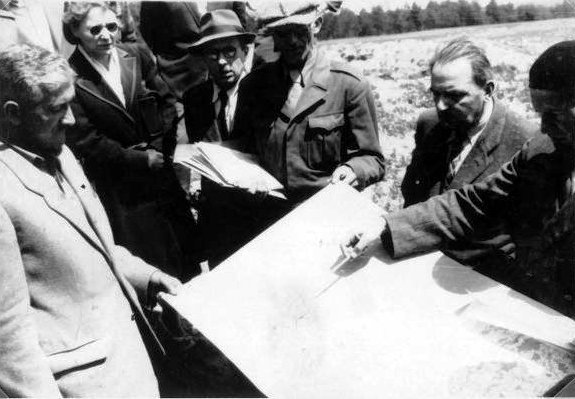 1947, the committee examines the Warsaw (?) camp, Rajzman is the main in the hat Source: U.S. Congressional House Committee on Foreign Affairs.
1947, the committee examines the Warsaw (?) camp, Rajzman is the main in the hat Source: U.S. Congressional House Committee on Foreign Affairs.Extermination camp Treblinka
The train went up on a sidetrack. The train was surrounded by barbed wire entanglements on all sides. We were led out of the train to a nearby square enclosed by a high fence of pine and fir branches.
The passengers who arrived on the train could not see what went on behind the fence. On the square the whole transport was divided, the women were directed to the barracks on the left, the men to the one on the right. Everyone was ordered to undress completely and to deposit all valuables and money in a special place – these were to be returned after the bath.
While undressing I saw Engineer Galewski of Warsaw, a friend of mine, among the workers. Galewski asked one of the Elite Guards to assign me to the workers’ brigade. I was told to dress and was placed in a group employed in carrying bundles of clothing from the square to the storehouses.
I never saw my traveling companions again, after a few minutes I understood everything. I felt resentment against Galewski, due to whose intervention I was still alive.
Carrying extremely heavy bundles, we had to run the gauntlet between lined up overseers who beat anyone they could lay their hands on with heavy sticks All those who carried bundles had swollen faces. By noon no one who knew me would have recognized me, for my face had become a bluish mass, my eyes were bloodshot.
During the pause for lunch I complained to my friend and reproached him for having saved me. His answer was unexpected: "I did not save you to keep you alive, " he whispered, "but to sell your life at a higher price. You are now a member of a secret organisation that is planning an uprising and you must live."
The camp of Treblinka occupied a clearing 1 mile square, surrounded by woods and situated about a mile and a half from the railway station at Treblinka, on the line Malkinia to Siedlice.
Beginning in July 1942, every day with only brief interruptions, trains bringing Jews to Treblinka arrived from all over Poland, Russia, Czechoslovakia, Germany, Bulgaria and Greece.
On the average, 3 to 4 trains of 60 cars arrived every day, each car containing 80 to 150 people. The trains traveled along a siding to the entrance gate, where the train escort got off and a camp escort received the deportees. Soldiers from outside were forbidden to cross the camp grounds.
Precautions to ensure secrecy went so far that an electric siren was placed on the main observation tower, to signal any German plane that approached to change its course. No plane ever flew over the camp.
The whole station was camouflaged in the most cunning fashion, thus, the large barracks adjoining the platform, which served as the main storehouse for the stolen clothes, was covered with timetables of trains that allegedly came to Treblinka station (some months later, when Treblinka had become famous, the name of the station was changed to Obermajden).
Then one saw a huge signpost bear the inscription: "To Bialystok and Baranowice," such signs as "Tickets" and "Stationmaster" and finally an enormous painted arrow with the words: "Change for East-Bound trains".
There was also a large station clock, inside these barracks there was nothing but clothes, shoes and rags, but incoming people had the impression that they were really at a junction, where they would change to another train going still further east.
Near the platform there was a stout fence abut 9 feet high with a gate through which the newly arrived were driven into a huge square. Their disappointment and surprise were overwhelming; instead of a junction, they were in a huge concentration camp.
On both sides of the square there were barracks and enormous piles, sometimes 9 feet high, of clothing and shoes. One could hear the rattle of excavators and the air was permeated with the odor of corpses. On the square, men were at once separated from women and told to undress and deposit their papers and valuables.
The most heart-rending scenes took place in winter when women were compelled to strip their children at temperatures of 20 to 30 degrees below zero in the yard or in open barracks whose walls were of thin plywood.
The unfortunate creatures had nervous shocks, cried and laughed alternatively, then wept desperately while standing in line in the cold, their babies pressed close to their breasts. The hangman lashed their naked bodies to force them into silence.
The naked women were then taken care of by barbers, every woman was shaved to the skin with a clipper, then sent to the bath establishment, which consisted of 10 cabins with room for 700 to 800 people each.
In these cabins there were even towels and rules posted; once the people were inside, the cabins were hermetically sealed and air pumped out with a machine – poison gas was used later. Thus the victims were suffocated to death.
They remained in the cabins for 10 to 20 minutes, the large numbers of others waiting in line for the "bath" made it impossible for the Germans to leave them there any longer.
Later the bodies of the suffocated were thrown on an open oven to be burned; frequently the victims gave signs of life after being thrown into the flames, but to this the German guard did not react at all.
Before the corpses were burned, a group of dentists verified whether they had any gold teeth, for these were torn out of the bodies.
The oven consisted of an enormous ditch with a concrete foundation and a grate made of rails. Under the grate, a strong fire blazed continuously, fed by some special fuel.
The workers from the transports arrived daily; as a reward for working one day, they were not sent to the cabins but were killed by a bullet in the back of the head. Death by shooting was really a great privilege.
Because little children at their mothers’ breasts were a great nuisance during the shaving procedure, later the system was modified and babies were taken from their mothers as soon as they got off the train. The children were taken to an enormous ditch, where a large number of them were gathered together, they were killed by fire arms and thrown into the fire.
When mothers succeeded in keeping their babies and this fact interfered with the shaving, a German guard took the baby by its legs and smashed it against the wall of the barracks until a bloody mass remained in his hands. The unfortunate mother had to take this mass with her to the "bath".
Only those who saw these things with their own eyes will believe with what delight the Germans performed these operations, how glad they were when they succeeded in killing a child with only three or four blows; with what satisfaction they pushed the baby’s corpse into the mother’s arms.
The invalids, crippled and aged who could not move fast were put to death in the same way as the children. The ditch into which the children and infirm were slaughtered and burned was called the "Lazarett" in German – infirmary – and the workers employed in it wore armbands with the Red Cross sign
The Germans boasted that the "infirmary radically cured all diseases".
Our guards were especially pleased when they succeeded in deceiving and making mockery of the deportees from abroad, especially those who were prominent in any way. For instance, one day a transport of deportees came from Germany, Austria and Czechoslovakia.
None of the new arrivals had any idea of what was in store for them, all were convinced they were to be settled here to work.
An old man, a prominent surgeon from Vienna, came out and explained to the Hauptsturmführer that he had brought with him a whole carload of special apparatus and surgical instruments.
He asked that the workers kindly be instructed to take care when unloading these tools because now, during the war, it was impossible to have them repaired should they be damaged. The Hauptsturmführer assured him very seriously that the instruments would not be unloaded until the professor returned from his bath and that he himself could supervise their transportation to the professor’s apartment. It goes without saying that the surgeon never returned from the "bath".
On another occasion an old lady of aristocratic appearance approached Untersturmführer Franz, the worst hangman and showed him her papers which indicated that she was a relative of the famous Sigmund Freud of Vienna.
She asked him to assign her to clerical work, since her age did not permit her to do any heavy work. Franz carefully verified her papers and told her to report to the main office of the camp immediately after her "bath" where she would have a pass prepared for her return to Vienna the same day. The lady thanked him graciously, undressed and happily went off to the bath cabin.
Still another example of brutality: an elderly deportee from Warsaw recognized in the Hauptsturmführer, a friend of his whom he had often met at international conferences abroad. The German official took him to the office (the only case when a Jew entered there) and an hour later one could see him walking toward the courtyard accompanied by the Hauptsturmführer’s friend [..] was in the oven.
The workers in the camp were divided as follows:
- Group I: Classifying the new articles, carrying clothes and baggage to storerooms
Group II: Storing stolen clothes and loading them on cars going back to Germany
Group III: Sorting, packing and counting money; foreign currency, gold and valuables
Group IV: Craftsmen such as shoemakers, tailors, carpenters, masons, locksmiths etc who worked in shops
Group V: Barbers
Group VI: Dentists
Group VII Porters to carry corpses to the oven
The workers of group VII were changed every few days. The other groups were in principle steady, but actually the life of every "steady" worker depended on the moods of the guards and they wanted only blood. There were thousands of pretexts for killing.
If a piece of bread coming from an outside bakery was discovered on a worker, the penalty was death. Death was meted out for not carefully removing the Jewish insignia from clothes of the murdered. Death for having kept a coin or a wedding ring, the last relic of the worker’s murdered wife.
The methods of execution were the following:
- 1. Lashing to death while cold water was constantly poured on the victim
2. Hanging on gallows by the feet
3. Tearing to pieces by dogs – Franz’ favorite amusement
4. The mildest form of death, yearned for by everyone – shooting
For drinking water during work, smoking a cigarette, improper saluting and similar offences, the penalties were from 50 to 100 lashes on the bare body, but usually the worker was finished after 50 lashes and if several pails of water did not bring him to, he was thrown into the fire.
As a result of starvation and living in unheated barracks during the winter of 1942-1943, an epidemic of typhoid broke out. A special office was set up, called he Krankenstube (sick bay), but when a worker with a temperature of 102 degrees reported to the physician and the latter recommended that he be put to bed in the Krankenstube, there appeared SS-Unterscharführer Miete whose specialty and favorite pastime was the "selection of workers." Five minutes later, the patient was taken to the "infirmary" where he was cured by a bullet.
In the last weeks of my stay in the camp, the Jewish physician succeeded in obtaining soporifics which were injected into each patient before he was executed; he was taken to the "infirmary" only after he had fallen asleep.
Dramatic scenes took place during the giving of injections, for sometimes other injections were given, to strengthen the heart for instance. Before taking an injection, the worker always said farewell to his comrades, because he suspected that the injection would put him to sleep, after which he would be sent to the "infirmary".
It also happened that a typhoid patient was sometimes given an injection by the order of Miete. Miete would ask the doctor when the patient would be asleep. The physician would answer: ‘in 20 minutes.’ 20 minutes later, stretcher bearers led by Miete would appear to find the patient eating his ration of black bread with a healthy appetite.
Consternation all around but His Excellency Elite Guard Miete must not fatigue himself for nothing, he would order the patient to be put on the stretcher and taken to the "Infirmary".
In vain the patient would weep and protest that he was now completely well. Five minutes later one would hear a shot. If so, the worker was fortunate for having disappointed Miete, he might have been hung by his feet, but all he got was a bullet.
How "steady" these workers crews were is best illustrated by the fact that 80,000 workers passed through the camp, while a maximum of 700 were employed at one time.
These are the names of some of the hangmen in the camp: deputy commander Kurt Franz, chief of the guards Kuttner, chief of the cemetery SS-Unterscharführer Floss, deputy chief of the guards August Miete, there were 36 other SS-Unterscharführer
Definitielijst
- brigade
- Consisted mostly of two or more regiments. Could operate independently or as part of a division. Sometimes they were part of a corps instead of a division. In theory a brigade consisted of 5,000 to 7,000 men.
- concentration camp
- Closed camp where people are being held captive that are considered to be anti- social, enemies of the state, criminal or unwanted individuals. These groups mostly do not get a fair trial or are condemned to doing time in a camp.
- Jews
- Middle Eastern people with own religion that lived in Palestine. They distinguished themselves by their strong monotheism and the strict observance of the Law and tradition. During World War 2 the Jewish people were ruthlessly persecuted and annihilated by the German Nazis. . An estimated 6,000,000 Jews were exterminated.
- mine
- An object filled with explosives, equipped with detonator which is activated by either remote control or by colliding with the targeted object. Mines are intended to destroy of damage vehicles, aircrafts or vessels, or to injure, kill or otherwise putting staff out of action. It is also possible to deny enemy access of a specific area by laying mines.
Images
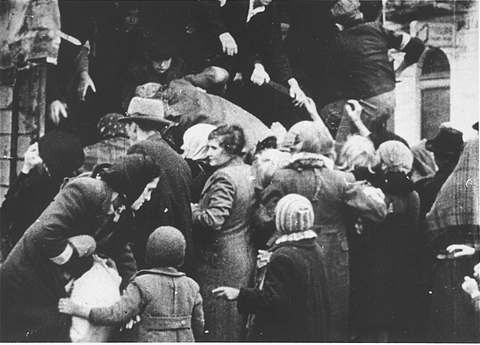 Jews captured by the SS during the suppression of the Warsaw ghetto are sent to Treblinka Source: U.S. Congressional House Committee on Foreign Affairs.
Jews captured by the SS during the suppression of the Warsaw ghetto are sent to Treblinka Source: U.S. Congressional House Committee on Foreign Affairs.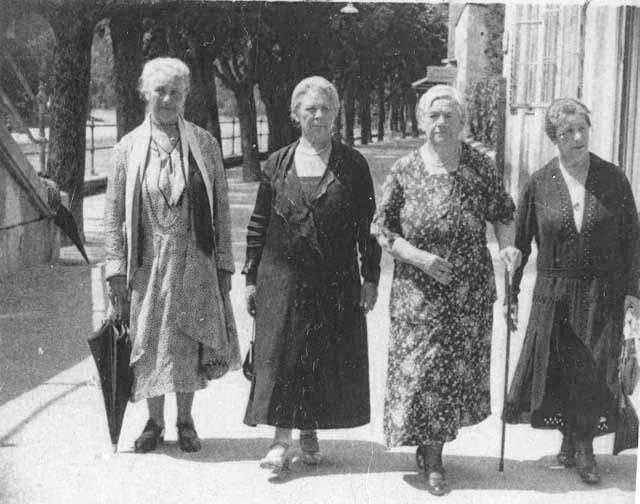 Sigmund Freud's sisters, Rosa is believed to have been killed at Treblinka Source: U.S. Congressional House Committee on Foreign Affairs.
Sigmund Freud's sisters, Rosa is believed to have been killed at Treblinka Source: U.S. Congressional House Committee on Foreign Affairs.The uprising
Among the first six groups there was a conspiratorial committee whose task was to avenge at least to some extent the millions of people executed. They dreamed of setting fire to the whole camp and exterminating at least the most cruel elements at the price of their own lives.
The work of organisation was difficult, because the Germans had several stool pigeons among the workers and all our moves had to be most carefully guarded.
Finally it was decided that the only practical plan was to get ammunition and arms from the camp’s arsenal. Luck favored us for a few days after this resolution was taken, one of the Jewish locksmiths was sent to repair the lock of the armored door of the arsenal, which was out of order. The locksmith took an imprint of the key and after four months work another key was ready.
Three combat units were then organized and our leader, Dr. Julian Chorazycki, a former captain in the Polish army, worked out a detailed plan of action. The coup was to take place on April 21, 1943.
Unfortunately, on April 19, Dr. Chorazycki failed to give an improper salute to SS-Untersturmführer Franz, who struck him in the face with his riding crop. Dr. Chorazycki reached for his knife and was about to strike. Franz jumped out of the window shouting that Chorazycki must be taken alive.
He was foiled in this design as the doctor had time to take poison. After Chorazycki’s death, our plan had to be postponed for several months because we had no qualified leader and none of us wanted to take moral responsibility for an unsuccessful coup.
On May 1, 1943, Dr. Leichert, a physician from Wegrow came to our camp; he was a former Polish officer as well and after a few days in the camp, he agreed to take leadership of our group.
We waited for an opportune moment to get into the arsenal. On August 2, 1943, when a large group of masons was working nearby, we finally managed to open it. Thus we were able to get one of our comrades into the building and lock him in.
One of the Unterscharführer lived in a room adjoining the arsenal and at that moment he happened to be in his quarters; the slightest rustle in the stack of weapons could have betrayed us. For that reason we delegated Engineer Sudowicz of Czestochowa to go to this Unterscharführer with whom he had good relations and under some pretext lure him out of his room.
At the same time, we cut a pane out of a window opposite the door at a spot that was unguarded. Outside the arsenal there was a pile of debris and bricks. A cart driven by member of our group drove up to the building, ostensibly to remove the debris. Under it, 20 hand grenades, 20 rifles and several revolvers with cartridges were loaded. All this was taken to the ditch where lime and gravel were kept for construction work and divided among the combat units.
The disinfector of the camp belonged to one of these units, his work in the camp consisted of walking around with a sprinkler full of disinfectant. We had got some gasoline from trucks and tanks in the garage through one of our comrades, a mechanic from Czestochowa.
On the day of the coup, this gasoline was poured into his apparatus instead of disinfectant and sprinkled it liberally according to our leader’s instructions. Curiously enough, the "disinfection" of one of our objectives took place in the presence of one of the Unterscharführer who did not notice anything.
At 3:45 p.m. we heard the signal, a shot near the gates of the Jewish barracks. This shot was followed by the detonation of hand grenades hurled at previously "disinfected " objects. An enormous fire broke out in the whole camp.
The arsenal exploded and everything was burned, except the bath cabins because it proved absolutely impossible to get near them. SS-Oberscharführer Kuttner, chief of the guards and the leading camp spy, was injured by this first shot and an unknown number of Trawninki guards were killed.
The flames devoured all the storerooms for clothes and shoes; of the 700 workers on the camp grounds, only 150 to 200 succeeded in escaping, the others perished in the camp. Of the 150 to 200 who managed to escape, 60 Jewish inmates were still alive at the end of the war; the others had been murdered by the German hangmen on return to the camp.
In the last 11 months of its existence, the leadership of Treblinka kept a meticulous record of deportees coming in and goods going out. The numbers of Jews were: some 120,000 from Germany; 40,000 from Austria; 1,5 million from Poland; 100,000 from Czechoslovakia; 14,000 from Bulgaria; 1 million from Russia, a total of 2,774,000. (Nowadays, lower numbers are considered. An estimated 800,000 people were exterminated in Treblinka. Editor). In the course of those 11 months, a few hundred million dollars worth of foreign currency, gold and valuables from Treblinka were sent to Germany through the official channels, in addition to suitcases full of goods that were stolen by the guards and sent off at their own expence.
Definitielijst
- Jews
- Middle Eastern people with own religion that lived in Palestine. They distinguished themselves by their strong monotheism and the strict observance of the Law and tradition. During World War 2 the Jewish people were ruthlessly persecuted and annihilated by the German Nazis. . An estimated 6,000,000 Jews were exterminated.
- moral
- The will of the troops/civilians to keep fighting.
Images
Information
- Published by:
- Arnold Palthe
- Published on:
- 14-10-2017
- Last edit on:
- 21-11-2023
- Feedback?
- Send it!
